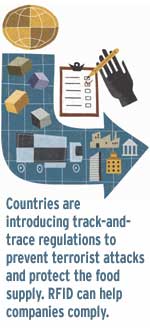Apr 01, 2004The age of deregulation is over, at least when it comes to the international movement of cargo and the tracking of food products. Since the terrorist attacks on New York and Washington on Sept. 11, 2001, the United States has introduced a number of regulations that require companies to provide accurate and detailed information on
shipments. Outbreaks of mad cow and hoof-and-mouth diseases and concerns about genetically modified foods have prompted the European Union to introduce track-and-trace requirements.
The regulations require companies to gather accurate, timely data, which means companies might need to invest heavily in people to manually scan bar codes or record information on products. None of the regulations introduced requires RFID tagging (a proposed U.S. animal-identification program recommends it). But as tag costs drop, RFID will become a cost-effective way to gather accurate data. That’s why companies would be smart to include regulatory compliance in their RFID plans and in their business-case analysis of the technology.
“To address the problem of food traceability, retailers and consumer packaged goods firms should use RFID tags to meet traceability compliance deadlines, integrate agricultural firms into the food chain, slash product-recall costs and probe RFID tags’ benefits with a clear business case,” Charles Homs, a senior analyst at Forrester Research, wrote in a recent report. “Using RFID tags to find goods in distribution centers, retail stores and trucks in transit will help firms respond within the predefined time limits to any official inquiry.”
Since 9/11, the United States has been working to secure the 17,000 shipping containers that enter the country each year. Less than 2 percent are opened and inspected, which raises the possibility that terrorists could hide weapons of mass destruction in a container and sneak them into the country. The U.S. Customs Container Security Initiative (CSI) was launched in 2002 to use information technology to identify and target high-risk shipments for inspection.
Poor information
The initiative requires all companies shipping goods from a foreign port to the U.S. to provide an electronic manifest of everything in the shipment 24 hours before it leaves port. But importers can’t always get good information from their suppliers. It’s not clear which pallets of goods are going into which containers and are being loaded onto which ships.
RFID could automate the data-collection process. The containers could then be sealed with a tamper-detection device to verify that they haven’t been opened and had their contents replaced. That would enable U.S. Customs to focus its inspections on the small number of containers from unknown shippers or those that have incomplete or suspect manifests.
Companies that are required to put RFID tags on pallets and cases bound for Wal-Mart’s distribution centers are in a good position to also use RFID to comply with the CSI rules and other laws (see The Growing Thicket). Cases of product made in Asia could be tagged at the source and tracked as they are loaded onto ships.
“If you have improper invoicing or inaccurate documentation associated with your cargo, that will slow a shipment down at customs points,” says Gordon Fuller, practice lead of secure logistics at Covansys, a systems integrator and outsourcing company. “If you don’t know what’s in each of your containers, that creates an opportunity for a terrorist to slip something in. But if you don’t know what’s in there, you are also costing your company money.”
The European Union has been less concerned about terrorism and more focused on protecting the food supply. Europeans are worried that genetically modified organisms (GMOs) could pose health risks to humans and indigenous plants and animals. Companies that want to sell their products in Europe have to know what GMOs their products contain. Today, most U.S. corn producers don’t distinguish between genetically modified and natural corn because maintaining separate inventories would be expensive. Even if growers were to rely on bar codes to distinguish between corn types, there would always be the possibility of human error allowing modified corn to get mixed with natural corn. RFID, however, could allow producers to track separate inventories automatically and alert workers before corns are mixed.
The demands on companies to identify and track products more closely are only going to expand in coming years. Many countries are moving toward mandatory tracking of livestock. Some are considering introducing track-and-trace requirements for certain classes of pharmaceutical drugs. And requirements for products to have labels identifying their country of origin will likely become standardized globally.

